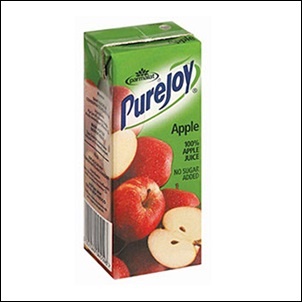
Parmalat South Africa has concluded its investigation into a batch of contaminated PureJoy apple juice, spokesperson André Mahoney told Health24.
"The investigation into the cause of the contamination has been completed."
The dairy producer announced in February that it was recalling all 200ml PureJoy apple juice (produced on December 14 and 15 2014 with the "best before" date of December 14 and 15 2015) from shelves in the majority of retail and wholesale stores.
Contaminated with cleaning chemicals
At the time Parmalat said about 60 litres of the product, which amounts to about 300 packs of the product, had been "contaminated with cleaning chemicals, making it unfit for consumption".
When asked by Health24 what the exact chemicals were, Mahoney revealed that it contained sodium hydroxide, better known as caustic soda.
Read: Parmalat SA PureJoy apple juice tainted with caustic soda
Caustic soda, a highly alkaline, white powder, is used to clean and sterilise production lines.
"The root cause shows that a part (the de-aerator) of the processing line which is connected to the filler but not used for all products packed on that line, contained residual cleaning liquid (caustic solution).
Positive public response
"The fault occurred when an unscheduled process (that should not have been available as a choice) was chosen by an operator who selected a cleaning step on the automated process control panel at the start of a production run that pushed this cleaning liquid into the product feed," said Mahoney.
He said this step is usually only selected at the end of the production run and before shut down.
Read: PureJoy juice is safe to drink, says Parmalat
Mahoney assured the public that corrective actions have been taken to prevent such problems in future.
"The cleaning process conditions have been changed to ensure additional water circulation of the de-aerator before production and the connections have been removed completely from the line for production of all other products. In addition, the cleaning step that the operator selected is now blocked and can only be selected by the supervisor under password control."

He said the media, customers and the general public have responded very positively to the request to return the product.
"We have received over 1 000 calls related to the recall since we went public and continue to respond directly to all those who have concerns and queries. As per our recall notice we have, where possible, collected samples from consumers and reimbursed them for product purchased."
Mahoney noted that global studies have indicated that best practice on a recall is at the 30% recovery rate and this was achieved by Paramalat too. He added that a slightly better recovery rate was recorded where most of the product was distributed.
A positive recall recovery rate
"In the 'high risk area' – which is where the contaminated packs were distributed and recovered - we have nearly a 45% recovery rate," he said.
"We are very grateful for all the efforts to bring this to the attention of our consumers. We continue to monitor this response and continue to find targeted ways to ensure that any remaining products that consumers may have in their possession are not consumed."
Mahoney said that the two consumers who initially complained about the product have been in direct contact with Parmalat. "We have addressed all their concerns."
Dangers of ingesting caustic soda
Director at the Griffon Poison information centre, Dr Gerhard Verdoorn, explained to Health24 the dangers of ingesting caustic soda.
He said the mucous membranes in the mouth and the oesophagus is where damage can be caused if ingested in any significant concentration. However, Verdoorn, indicated that the pH levels in the stomach, which varies from 1-2 up to 4-5, should help neutralise the chemical.
The symptoms to look out for are vomiting, diarrhoea, abdominal pain and cramps and any signs of blood in the stool or when vomiting.
"If you rub your lips with your finger, your skin should come off. You will feel a soapy feeling on your lips and in your mouth. If it is not significant, you will not feel anything and it may not cause any damage," said Verdoorn.
It is advised that the best way to deal with such an incident is to call a poison control centre immediately as well as emergency services.
Also read:




 Publications
Publications
 Partners
Partners










